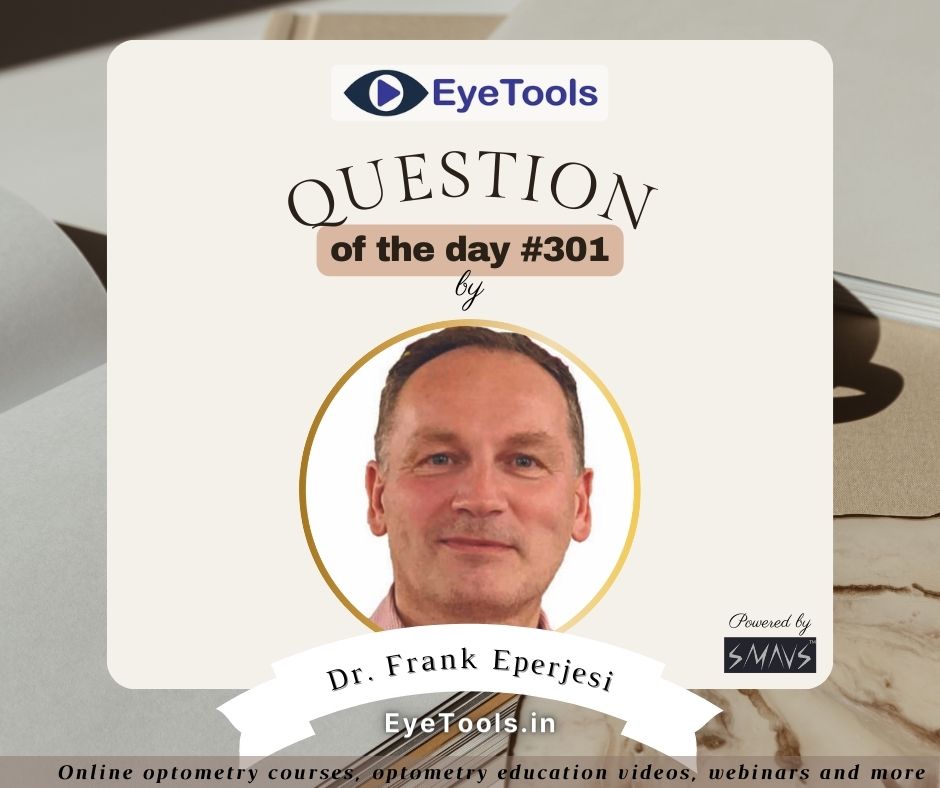
Welcome to question of the day #301
I work in community practice and use subjective refraction to determine the optimum lens power that will provide the best vision for my patients. I find it difficult sometimes to work out which lens is the best for the spherical element, the cylindrical element, and the cylinder axis. Do you have any suggestions as to how I can better at determining the endpoint for each of these parts of the prescription?
Subjective refraction is challenging because it is…subjective. It relies so much on the comments made by the patient as to how well they can see with each lens offered during the refraction process. I am not being disrespectful when I say that the most unreliable aspect of an eye examination is the patient and especially what the patient tells us.
It is up to the clinician to help the patient be as accurate as they can. Remember most people have an eye examination every two years or so but as eye care specialists we will conduct many hundreds every month. Clear, short instructions spoken in a slow direct way will help the patient as will reassurance that they are doing a good job and you understand that some of the choices are difficult. Patients worry that they will say the wrong thing and get the wrong glasses.
I’m lucky that I work in a long-established practice where patients come back regularly. In my clinic yesterday I saw 13 patients and only one was new to the practice. The rest all had at least 10 years worth of record cards from previous eye examinations. I can see what their current prescription is and know that the new one is likely to be close to the current one unless they have significant corneal or lenticular changes. Knowing what the current prescription is, helps me decide when I have reached the refraction endpoint.
If the patient is new and has glasses I can focimeter them. Accurate focimetry and knowing what the current prescription is will help me get to the refraction endpoint.
I place the current prescription in the trial frame. When I’m working on the monocular spherical component I place a +0.25 sphere over the other lenses in the trial frame and ask if the smallest letters the patient can see are just as clear with this lens or if are they more blurred. I repeat this until the patient tells me the over lens makes the letters blurred. I then go back one step and reduce the plus by +0.25 to get to the endpoint of the spherical component. Some patients will give a quick, sharp answer ‘It’s more blurred’ or ‘it’s the same’. Others will hesitate and hesitation means that the difference is difficult for them to see which means the end point is near.
The same with the cylinder. The current cylinder is in the trial frame and I work on the axis first. I use a set of two small black circles (Verhoeff rings) on a light background as my target and advice the patient that I’m going to show them two lenses and ask with which lens the circles are roundest and sharpest, that neither lens will make the circles perfect but I looking for the lens which makes them best.
Yesterday I didn’t make my instructions clear because a patient said to me that the circles are the right were the clearest.
I then present lens one and lens two. Again, when the axis is a lot different from the one in the trial frame for small cylindrical corrections or a little different for large cylindrical corrections (1.25 and above) people quickly respond and sharply. When a patient hesitates, it means that the end point is near.
To determine the cylinder lens power, I hold -0.25 and +0.25 cylindrical lenses from the trial set in turn over any cylindrical lens in the trial frame and ask the patient if each over lens makes the smallest letters seen sharper or more blurred. I work this way to get to the cylindrical power endpoint
Look out for a patient’s hesitation as this is likely to be an indicator that you are close to the end.
Throughout the testing, I encourage and reassure the patient that I am cross-checking their responses and that they are doing a good job.



1.jpg)



.jpg)
.jpg)



_(Instagram_Post).jpg)
.jpg)
_(1080_x_1080_px).jpg)


with_UP_Cabinet_Minister_Sh_Nand_Gopal_Gupta_at_OpticsFair_demonstrating_Refraction.jpg)
with_UP_Cabinet_Minister_Sh_Nand_Gopal_Gupta_at_OpticsFair_demonstrating_Refraction_(1).jpg)

.jpg)








.jpg)



.png)




